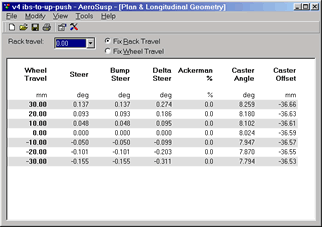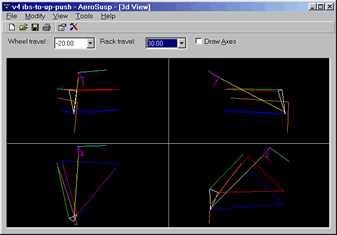AeroSusp
v4
3d suspension geometry and kinematics analysis
AeroSusp is
for use by designers creating suspension systems from scratch and by race
engineers tuning existing systems. It is based on mature code that has been in
widespread use in top level race teams in many categories for over 15 years.
AeroSusp has been carefully designed
from the start to avoid the pitfalls of over-complicated user
interface design that other suspension design products have fallen
into.
Typically you can be productive with it within a few minutes of
starting.
|
Example
screenshots of some of the many output views available - click for a
bigger picture |
|
 |
 |
|
|
|
|
 |
 |
Major features
 Professionally designed for ease-of-use and powerful functionality
Professionally designed for ease-of-use and powerful functionality
-
High quality user interface complying
with the MS Windows User Interface Guidelines means you can be
productive in the shortest time.
-
On-line Help system means that
information is always to hand.
-
Combines exceptional usability with a
rich feature set.
-
Command line automation for batch running in external
workflows
|
 Models most common double wishbone suspension configurations, including:
Models most common double wishbone suspension configurations, including:
-
Wishbones and track rod but no springing
system (for wheel control behaviour only).
-
Inboard spring actuated by pushrod or
pullrod via rocker.
-
Pushrod or pullrod connected to wishbone
or direct to upright.
-
2nd rocker in series with first.
-
Outboard spring.
-
Inboard spring actuated by top wishbone
beam rocker.
Driveshafts and anti-roll bars can also
be modelled.
|
 Steers and heaves suspension over a full range automatically
Steers and heaves suspension over a full range automatically
-
The suspension can be moved into bump
and droop with your choice of step.
-
You can also choose to steer over a
range of rack positions for each heave position.
-
Results for all heave and rack positions
are always available, removing the need to move the suspension into a
position of interest.
-
You can view results against a range of
rack or wheel travel, or at a particular combination of travels.
|
 Over 40 geometry channels output depending on the suspension type,
including:
Over 40 geometry channels output depending on the suspension type,
including:
-
Anti-dive, -squat and -roll angles and %
-
Ackerman length, half track, roll-centre
heights from origin and ground.
-
Bump steer, camber angle, castor angle,
kingpin inclination, scrub radius, trail.
-
Force ratio, spring length, wheel rate
and wheel rate % change due to spring only, wheel rate due to spring +
tire + installation stiffness.
-
And more...
|
 Wide choice of results displays
Wide choice of results displays
-
There are a number of pre-formatted
tables showing useful groups of results channels against wheel travel
-
All output channels can be plotted as
auto-scaled graphs against wheel travel.
-
You can draw the suspension as a set of
3d views.
-
Any display can be printed with full
print preview, or you can define your own set of tables to print.
|
 Link loads for stressing calculations
Link loads for stressing calculations
-
You can view tables of loading
coefficients defining coupling between contact patch loads and
tension/compression loads in wishbone and pushrod/pullrod links.
-
You can define load cases for contact
patch loads. The resultant combined loads are automatically calculated
for the links.
-
This feature highlights potential
problems with highly loaded links, and directs your attention to the
most critical parts.
|
 Dynamics report
Dynamics report
-
AeroSusp can create a simple dynamic
report giving ride height change under acceleration or braking,
including the effects of tire compression, suspension member
installation stiffness and anti-dive or squat, as well as the basic
spring rate.
|
 Suspension lengths and positions in bump and droop
Suspension lengths and positions in bump and droop
-
A report showing the lengths of all
suspension links is created, making it easy to check the accuracy of
measurements made on an existing suspension.
-
The wheel is moved up and down and and
steered from the original position, and the new coordinates of all
points found.
|
 Automatic curve fitting for key channels against wheel travel
Automatic curve fitting for key channels against wheel travel
 Other features
Other features
-
You can work in either US/Imperial or
Metric units, with sensible defaults set for both systems.
-
Tables can be exported in ASCII format,
for use in other applications.
|
Planned features
This program is currently under continuous development. If you are particularly interested in a
feature not currently implemented please
contact Ansible Design
for further information.
|